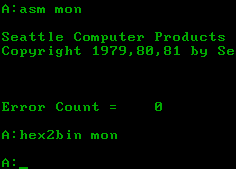DOS
Disk Operating System (DOS) is a family of disk operating systems that operate on IBM PC compatibles. DOS is an important part of computer history, as it was widely used in the 1980s and early 1990s before the rise of graphical user interfaces (GUIs), most notably with Microsoft Windows. DOS systems are single-tasking operating systems that use a command line interface (CLI) for user interaction.
History[edit | edit source]
The history of DOS dates back to the early 1980s. The most well-known version, MS-DOS (Microsoft Disk Operating System), was introduced by Microsoft in 1981 after being commissioned by IBM for its first personal computer. MS-DOS was based on QDOS (Quick and Dirty Operating System), which Microsoft purchased from Seattle Computer Products. Other versions of DOS include PC-DOS, DR-DOS, and FreeDOS.
Functionality[edit | edit source]
DOS systems manage files stored on disk drives and provide a set of basic commands for file management, including copying, moving, and deleting files. They also manage memory allocation for programs and handle input and output operations. Despite their simplicity, DOS systems require users to learn command-line syntax, making them less accessible to casual users compared to GUI-based systems.
Legacy[edit | edit source]
While DOS is no longer widely used as a primary operating system, its influence is still felt today. Many of its commands and concepts have been incorporated into the command-line interfaces of modern operating systems, such as Windows Command Prompt and PowerShell in Windows, and the terminal in Unix and Linux systems. Additionally, DOS-based software and games continue to be enjoyed by enthusiasts through emulation and virtualization technologies.
See Also[edit | edit source]
Search WikiMD
Ad.Tired of being Overweight? Try W8MD's physician weight loss program.
Semaglutide (Ozempic / Wegovy and Tirzepatide (Mounjaro / Zepbound) available.
Advertise on WikiMD
|
WikiMD's Wellness Encyclopedia |
| Let Food Be Thy Medicine Medicine Thy Food - Hippocrates |
Translate this page: - East Asian
中文,
日本,
한국어,
South Asian
हिन्दी,
தமிழ்,
తెలుగు,
Urdu,
ಕನ್ನಡ,
Southeast Asian
Indonesian,
Vietnamese,
Thai,
မြန်မာဘာသာ,
বাংলা
European
español,
Deutsch,
français,
Greek,
português do Brasil,
polski,
română,
русский,
Nederlands,
norsk,
svenska,
suomi,
Italian
Middle Eastern & African
عربى,
Turkish,
Persian,
Hebrew,
Afrikaans,
isiZulu,
Kiswahili,
Other
Bulgarian,
Hungarian,
Czech,
Swedish,
മലയാളം,
मराठी,
ਪੰਜਾਬੀ,
ગુજરાતી,
Portuguese,
Ukrainian
Medical Disclaimer: WikiMD is not a substitute for professional medical advice. The information on WikiMD is provided as an information resource only, may be incorrect, outdated or misleading, and is not to be used or relied on for any diagnostic or treatment purposes. Please consult your health care provider before making any healthcare decisions or for guidance about a specific medical condition. WikiMD expressly disclaims responsibility, and shall have no liability, for any damages, loss, injury, or liability whatsoever suffered as a result of your reliance on the information contained in this site. By visiting this site you agree to the foregoing terms and conditions, which may from time to time be changed or supplemented by WikiMD. If you do not agree to the foregoing terms and conditions, you should not enter or use this site. See full disclaimer.
Credits:Most images are courtesy of Wikimedia commons, and templates, categories Wikipedia, licensed under CC BY SA or similar.
Contributors: Prab R. Tumpati, MD



